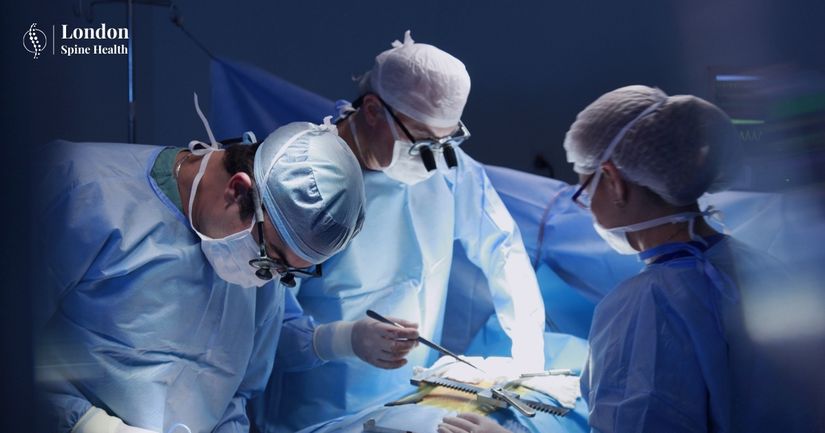A herniated disc is one of the most common causes of back and leg pain, often leading to sciatica, numbness, or weakness. While the diagnosis may sound alarming, most patients improve with non-surgical treatments. Surgery is only considered when symptoms persist or neurological function is at risk.
At London Spine Health, we guide patients through every step of care. This article explains the typical treatment pathway for a herniated disc, from conservative management to advanced surgical options.
Step 1: Initial Assessment and Diagnosis
- Clinical evaluation: Your journey begins with a consultation and physical examination.
- Imaging tests: MRI or CT scans confirm the diagnosis and pinpoint the affected disc.
- Symptom review: We look at severity, ranging from mild back pain to radiating leg pain or even neurological weakness.
This first step ensures that your treatment plan is personalised and based on your needs.
Step 2: First-Line Non-Surgical Care
For most patients, the first recommendation is conservative treatment. Around 80–90% of herniated discs improve without surgery.
- Rest and activity modification: Short-term rest, avoiding heavy lifting or twisting, while staying gently mobile.
- Medication: Anti-inflammatories, pain relief, or muscle relaxants to control discomfort.
- Physiotherapy: Strengthening and flexibility exercises help stabilise the spine.
- Heat or cold therapy: Reduces muscle spasms and inflammation.
The goal is to relieve pain, reduce inflammation, and allow the disc to heal naturally.
Step 3: Advanced Non-Surgical Options
If symptoms persist after several weeks, more targeted treatments may be considered:
- Epidural steroid injections: Anti-inflammatory medication injected near the affected nerve root to reduce swelling and pain.
- Nerve root blocks: Both diagnostic and therapeutic—helping identify the pain source while offering relief.

The main Goal is to prolong non-surgical relief and delay or avoid surgery when possible.
Step 4: When Surgery Becomes Necessary
Surgery is usually considered if:
- Severe pain continues despite 6–12 weeks of conservative treatment.
- You develop progressive weakness, numbness, or neurological deficits.
- There are signs of cauda equina syndrome (loss of bladder/bowel control), which requires urgent surgery.
At London Spine Health, our specialists recommend surgery only when clearly necessary and when the benefits outweigh the risks.
Step 5: Surgical Treatment Options
Thanks to advances in technology, surgery for herniated discs is now minimally invasive in many cases.
- Microdiscectomy: A small incision is made, and only the portion of the disc pressing on the nerve is removed.
- Endoscopic or robotic-assisted surgery: Performed through even smaller incisions, leading to faster recovery.
- Spinal fusion (rarely required for isolated herniated discs): Used if there is spinal instability alongside the herniation.

Benefits: Relieves nerve compression, restores mobility, and significantly reduces pain.
Step 6: Recovery and Rehabilitation
- Hospital stay: Most minimally invasive procedures require only a short stay or are even day cases.
- Early mobilisation: Patients are encouraged to walk within hours of surgery.
- Physiotherapy and rehab: Helps restore strength, posture, and mobility.
- Return to normal activities: Many patients resume light activities within 2–4 weeks, though full recovery varies.
At London Spine Health, recovery programmes are tailored to get you back to work, exercise, and everyday life safely.
The Treatment Pathway at a Glance
- Assessment & Imaging → Diagnosis confirmed.
- Initial Non-Surgical Care → Rest, medication, physiotherapy.
- Advanced Non-Surgical Options → Injections, nerve root blocks.
- Decision Point → Symptoms reviewed at 6–12 weeks.
- Surgical Care → Microdiscectomy, minimally invasive procedures if needed.
- Rehabilitation → Gradual return to daily life.
Conclusion
A herniated disc doesn’t always mean surgery. In fact, most patients recover with non-surgical care. For those who need surgery, modern robotic and minimally invasive techniques offer quicker recovery and less pain.
At London Spine Health, our multidisciplinary team helps you navigate the entire treatment pathway, from first consultation to full recovery, with care tailored to your condition and lifestyle.
